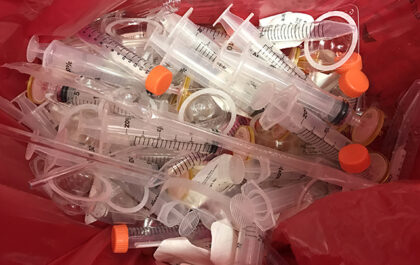Clean water is a fundamental and irreplaceable resource with paramount importance for both human well-being and the environment. Access to safe drinking water is a fundamental human right, but unfortunately, contaminated water sources still pose significant health hazards in many parts of the world. It is a hidden danger that hides below the surface and poses a serious risk to public health.
While we frequently take access to clean water for granted, the effects of its pollution can be serious and widespread. In this article, we will explore seven ways contaminated water can be a health hazard.
Table of Contents
1. Waterborne Diseases
Cholera, dysentery, typhoid, and hepatitis A are just a few of the many waterborne illnesses that can spread through contaminated water. Microorganisms like bacteria, viruses, and protozoa, all of which thrive heavily in this filthy water, are the cause of these diseases.
These pathogens can cause havoc on our health by constantly attacking our digestive system. Constipation, severe dehydration, nausea, vomiting, diarrhea, and abdominal discomfort all signal distress. These illnesses also have the potential to become life-threatening in their most severe forms. For example, untreated cholera can quickly lead to severe dehydration, shock, and death.
These waterborne illnesses can become widespread in areas with a lack of clean water, creating a cycle of misery and complications.
2. Chemical Contaminants
Chemicals can enter the water supply through industrial runoff, agricultural pesticides, and incorrect disposal of dangerous substances.
One example is the US Camp Lejeune water contamination case, where residents and military personnel were exposed to harmful substances like trichloroethylene and perchloroethylene due to poor waste disposal techniques. Now, people who spent at least 30 days residing or working at Camp Lejeune from August 1, 1953, to December 31, 1987, and experienced health issues are qualified to submit Camp Lejeune Water Contamination Claims and demand financial aid more than what the Veterans Affairs Office offers.
Some of these chemicals have even been linked to cancer, so exposure to them can result in a variety of health problems. The delicate hormonal balance in our bodies can also be upset by pesticides and industrial pollutants, which can result in developmental disorders, reproductive problems, and even fertility concerns.
3. Heavy Metal Poisoning
Certain water sources harbor a hidden danger in the form of heavy metals such as lead, arsenic, and mercury. These metals find their way into our drinking water through industrial pollution or naturally occurring deposits, posing a significant health risk to those exposed. Prolonged consumption of water filled with these heavy metals can result in a condition known as heavy metal poisoning.
For instance, lead is known for having dire consequences, especially for children. Exposure to lead can cause behavioral problems, developmental delays, and cognitive impairments, even at low levels of exposure. Adults who have been exposed to lead may experience neurological issues, kidney problems, or cardiovascular issues.
4. Microplastics
The tiny plastic particles known as microplastics have become a major hazard to our water supplies, mostly as a result of the widespread use of plastics.
The capacity of microplastics to absorb and concentrate dangerous poisons and chemicals from their environment is one of the most worrisome elements. These ingested substances can include endocrine-disrupting chemicals, insecticides, and heavy metals. Aquatic species that consume microplastics can unintentionally transmit these dangerous materials into the food chain.
Furthermore, there is growing concern that microplastics in seafood and water may disturb the digestive system and perhaps release toxic substances into human bodies.
5. Parasitic Infections
By hosting parasite organisms like Giardia and Cryptosporidium, contaminated water creates the conditions for potentially fatal and crippling health effects. Giardia or Cryptosporidium-contaminated water can cause severe gastrointestinal infections indicated by diarrhea, abdominal pain, nausea, and vomiting. These symptoms, especially in those at risk, like newborns and young children, can quickly worsen into a dangerous cycle of dehydration and starvation.
It is difficult to get rid of them from water supplies because they can develop resilient cysts that can withstand harsh environmental conditions and even chlorine-based water disinfection processes.
6. Algal Blooms
Harmful algal blooms (HABs) are a menace in the area of water contamination. Some HABs can create cyanotoxins, which can contaminate our water supplies and pose serious risks to the health of people.
These pollutants may cause chronic health concerns since they have been connected to liver and kidney damage. Acute symptoms from cyanotoxin ingestion include nausea, vomiting, diarrhea, and abdominal pain. Individuals can be in danger even from leisure activities like swimming or boating in contaminated waterways since cyanotoxins can enter the body through the skin and could cause skin rashes and irritation.
Moreover, people who live close to contaminated bodies of water run the danger of respiratory problems from inhaling aerosolized cyanotoxins, which are harmful to their health.
7. Antibiotic Resistance
In addition to the numerous health problems currently associated with contaminated water, this new danger is the spread and growth of bacteria that are resistant to antibiotics. This phenomenon poses a grave threat to public health by undermining our ability to effectively tackle infectious diseases.
These bacteria thrive in water sources that have been contaminated by antibiotic-resistant bacteria. Antibiotic resistance is a result of the misuse and inappropriate disposal of antibiotics in home, healthcare, and agricultural settings. These microorganisms, also referred to as superbugs, can survive in water systems and can infect people through ingestion, leisure, or agricultural runoff.
It becomes more and more difficult to treat people who have these superbug infections with standard medications. This reduces the power of our arsenal against infectious diseases, making previously curable infections potentially fatal. Risks are increased for vulnerable groups like the elderly, children, and people with weakened immune systems.
Conclusion
Contaminated water is one of the many complex environmental problems facing society today, endangering people’s health. Our water sources contain a wide range of serious risks, such as heavy metals, microplastics, antibiotic-resistant bacteria, and waterborne diseases. However, these hazards can be reduced with information, awareness, and teamwork. Not only is access to clean, safe water a fundamental human right, but it is also the foundation of well-being. Its cleanliness must be preserved through effective water treatment, strict pollution control, and prudent resource management.
Related posts
When was the first presidential election in the US?
The election process in the world’s most powerful nation, the US, has come a long way. Various amendments have been made to the Constitution that allowed black men, white women and other disadvantaged groups to participate in the elections. Further amendments during the 60s and…
Tips & Trick For Healthy Glowing Skin
Lorem ipsum dolor sit amet, consectetur adipiscing elit. Nam laoreet, nunc et accumsan cursus, neque eros sodales lectus, in fermentum libero dui eu lacus. Nam lobortis facilisis sapien non aliquet. Aenean ligula urna, vehicula placerat sodales vel, tempor et orci. Donec molestie metus a sagittis…
My Fight With Depression. Concussions
Lorem ipsum dolor sit amet, consectetur adipiscing elit. Nam laoreet, nunc et accumsan cursus, neque eros sodales lectus, in fermentum libero dui eu lacus. Nam lobortis facilisis sapien non aliquet. Aenean ligula urna, vehicula placerat sodales vel, tempor et orci. Donec molestie metus a sagittis…
Top 10 most visited tourist places in the world
Lorem ipsum dolor sit amet, consectetur adipiscing elit. Nam laoreet, nunc et accumsan cursus, neque eros sodales lectus, in fermentum libero dui eu lacus. Nam lobortis facilisis sapien non aliquet. Aenean ligula urna, vehicula placerat sodales vel, tempor et orci. Donec molestie metus a sagittis…
How Digital Health Technology Is Beneficial?
Digital health revolves around the usage of diverse technological platforms including mobile health, teen health, configurable remote patient monitoring, etc to improve the connection between the patients and the doctors. Across the healthcare system, the horizon and scope of digital health have helped create opportunities…
How Latest Farmtrac Tractors are Improving Farming in India?
India mostly relies on farming, and a large part of the population depends on it for their livelihoods. Recently, there’s been a big shift towards using modern farming techniques and machinery to make farming more productive and efficient. A good example of this is the…
Dispelling Myths: Demystifying Rx Waste and Expiration Dates – WasteX Pharmaceutical Waste Disposal Separates Fact from Fiction
The specter of “expired” medication looms large, conjuring images of potent chemicals wreaking havoc on water sources and ecosystems. But before you panic toss that bottle of pills, let’s delve into the truth about pharmaceutical waste and expiration dates, separating fact from fiction. At WasteX…
Sustainable Living in Memphis: Green Initiatives and Eco-Friendly Hotspots
Memphis, a city known for its rich cultural heritage and vibrant atmosphere, is increasingly becoming a hub for sustainable living. As environmental awareness continues to grow, residents and businesses in Memphis are embracing green initiatives and fostering eco-friendly practices. Let’s explore the city’s commitment to…
Today's pick
Hot topics
Stay connected
Meet the Author

Gillion is a multi-concept WordPress theme that lets you create blog, magazine, news, review websites. With clean and functional design and lots of useful features theme will deliver amazing user experience to your clients and readers.
Learn moreCategories
- Animals (7)
- Apps & Softwares (8)
- Automotive (8)
- Beauty (8)
- Business (141)
- Cars (12)
- Cartoon (3)
- Cook (4)
- Cooking (1)
- Design (8)
- Economy (6)
- EDUCATION (25)
- Entertainment (16)
- Fashion (23)
- Fitness (2)
- Food (16)
- Gaming (51)
- Guide (20)
- Health (119)
- Home (52)
- Home improvement (12)
- Interior (3)
- Law (16)
- Life (1)
- LifeStyle (99)
- Marketing (5)
- Motivation (9)
- Movie (6)
- Movies (1)
- Music (3)
- News (8)
- Painting Art (1)
- People (15)
- Photography (7)
- Review (113)
- Services (7)
- Social Media (6)
- Sport (9)
- Sports (12)
- Style (10)
- Swimming (1)
- Tech (125)
- Travel (26)
- Uncategorized (17)
- Vape (5)
- Western (3)
- World (2)










